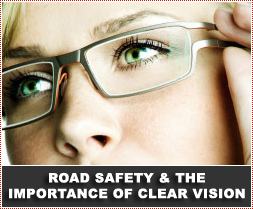Introduction

The ability of the driver to have good vision is an important part of driver fitness. We have provided insight pertaining to the requirement of clear vision in this article.
Visual acuity
This is the ability to judge space and the relative distance between objects or between an object and the vehicle. Depth perception depends on good binocular vision, essential for judging whether a car can be passed safely in the face of oncoming traffic and when moving from one lane to another among moving vehicles.
This is the ability to focus and see clearly with both eyes, individually as well as together. With good acuity, you will see detail very easily. In the case of drivers, it is particularly vital in identifying road signs, cyclists, pedestrians and animals. Peripheral vision This is the ability to see over a wider area without moving either the eyes or the head sometimes called “looking out of the corner of your eyes”. It refers to your total field of vision.
Night vision
This is the ability to see in the area of low illumination beyond your headlights, to see in the presence of the glare of oncoming headlights and to recover quickly from its effects. Night vision deteriorates with age and older drivers with reduced vision will need to exercise greater care when driving at dusk and at night and should have proper driving spectacles.
Why Good Vision Is Needed for Safety on the Road
The eyes control most of your movements and decisions while driving. With good vision and visual comfort, you can drive safely by maintaining concentration. Daylight vision problems are usually worse at night, increasing the risk of driving.
Many motor vehicle accidents are caused by drivers’ poor vision. According to most parties involved in an accident, the other driver “must have been blind”.
Let’s look at some of the possible causes of these accidents:
- The driver’s vision is below the recommended standard. He could have a visual deficiency such as nearsightedness, farsightedness or astigmatism. Cataracts could also affect the driver’s vision.
- Failure to wear spectacles or contact lenses where they have been prescribed for distance use.
- Low visibility due to darkness or adverse weather conditions, including extreme heat.
- Driving too fast. The normal field of vision is 180°. At 95 km/h the field of vision is only a quarter of its normal size. This means that the faster you drive, the less you see to the side.
- Glare in the driver’s eyes.
- A dirty windscreen.
- The distraction of the driver from either inside or outside the vehicle.
- Reduced mental alertness because of fatigue, alcohol, drugs, boredom, or general physical condition.
Tips for Easier, Safer Driving
- If you have prescription spectacles for driving, make sure you always wear them.
- Wear professionally prescribed sunglasses to protect your eyes from sun glare. They will also screen out harmful ultraviolet radiation.
- Ensure your windscreen is always clean and scratch-free, both inside and out.
- Make sure your headlight glass is clean, that the bulbs are in good working order and that the lighting system is properly positioned.
- Don’t stare at oncoming headlights – it takes longer to recover from the glare. Look a little to the left.
- Allow your eyes to adapt to lower light levels when moving from brightly lit areas to darker areas.
- The golden rule of night driving is “Speed must go down with the sun”.
- Good driving needs a good vision. It is your personal responsibility to be certain you have the visual skills necessary to drive safely. The eyes, like the rest of the body, change throughout life. Good vision 5 years ago does not imply good vision today.
Tips for Easier, Safer Driving
- If you have prescription spectacles for driving, make sure you always wear them.
- Wear professionally prescribed sunglasses to protect your eyes from sun glare. They will also screen out harmful ultraviolet radiation.
- Ensure your windscreen is always clean and scratch-free, both inside and out.
- Make sure your headlight glass is clean, that the bulbs are in good working order and that the lighting system is properly positioned.
- Don’t stare at oncoming headlights – it takes longer to recover from the glare. Look a little to the left.
- Allow your eyes to adapt to lower light levels when moving from brightly lit areas to darker areas.
- The golden rule of night driving is “Speed must go down with the sun”.
- Good driving needs a good vision. It is your personal responsibility to be certain you have the visual skills necessary to drive safely. The eyes, like the rest of the body, change throughout life. Good vision 5 years ago does not imply good vision today.